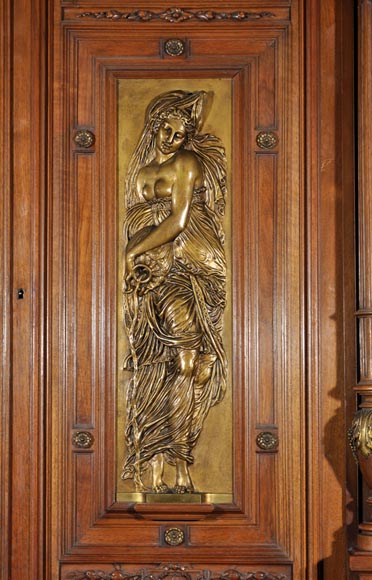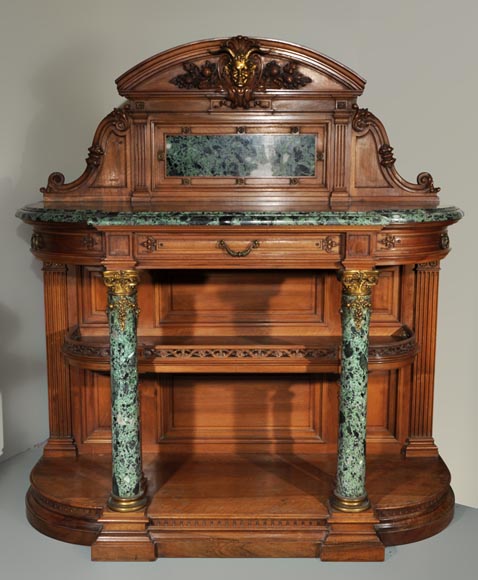Style Napoleon III / Ref.17441
Eugène Frager, Meynard Manufacture (cabinetmaker), Ferdinand Barbedienne (bronze manufacturer), Louis-Constant Sevin (ornemanist) - Exceptional Neo-Renaissance style dining room set made out of carved walnut
Dimensions
Width 90'' ½ 230cm
Height 107'' ⅞ 274cm
Depth: 27'' ⅛ 69cm
Origin:
Circa 1890
Status:
In very good condition.
Walnut, Antique green marble, gilded bronze. The buffet cabinet was shown at the Salon des Industries du Mobilier, an exhibition held at the Grand Palais in Paris, from July-November 1902. The set includes a buffet cabinet, a dessert table, a dinner table and eight chairs (six caned chairs and two upholstered chairs), this dining room set made out of carved walnut is elaborately decorated with gilded and chiseled bronze and Vert Antique marble. The large buffet cabinet with two bodies, possesses, on the upper body, two doors framed by two columns supporting an arched and broken pediment. On either side there are two glass semi-circular windows with a mirror. Two drawers on the table top transition into the lower body, composed of four doors, the two lateral doors copying the rounded shape of the upper body. An elaborate decor enhances this dining room set. Two large nymphs carved in low relief out of gilded bronze, made by Ferdinand Barbedienne, directly inspired by the fountain of Innocents made by Goujon during the 16th century, decorate the doors found on the upper body. They are framed by plaques made out of Vert Antique marble, this material is also used on the columns and the low-relief diamond shaped features on the lower body. Vases decorated with vine branches and branches of grapes, capitals with reversed volutes and floral wreaths, drawer handles, Satyr mask in the pediment's center, are some of the many gilded and chiseled bronze elements found on this buffet cabinet. The dessert table, with the top shelf made out of Vert Antique marble, takes on the same decorative principle in an attempt to form a homogenous set. A shelf below, also restricted by its rounded angles and openwork design, takes on the general shape of the piece of furniture whilst imitating the shape of the upper part. Like the buffet cabinet, the table top includes a drawer with a handle in the shape of a garland, in gilded bronze. The dessert table is topped with a large cartouche made up of volutes, in the center of which is a rectangular plaque made out of green marble topped with an arched pediment, which is also decorated in the center with a Satyr mask. A large table with a rounded table top and corners is supported by six fluted feet, with rings of gilded bronze. They are linked together by a bar from which four columns support the table. A set of eight chairs completes the item. A chair with an upright straight back, enhanced by a fringed backrest, is flanked by two detached columns which support an elaborate cartouche. The rectangular seat rests on four feet in the form of columns, linked together by an X shaped bar. Due to its architectural shape and its direct reference to the decorative repertoire of French Renaissance, this dining room set is characteristic of the Neo-Renaissance style, recognised towards the end of the 19th century. The abundant materials used and the care taken in the design and details make this set a great piece of work. Made around 1890 and the result of collaboration between cabinet maker Eugène Frager, successor of the Maison Meynard, and the bronze maker Ferdinand Barbedienne, this dining room set is also representative of the union of arts which was happening during this time. True dynasty of wood carvers, the Maison Meynard was set up in 1812, at 50 rue du Faubourg Saint Antoine. Having taken on the family business in 1873, Léon-Guillaume Meynard won a gold medal during the Universal Exhibition of 1878 in Paris. In 1889 he sold the business to Eugène Frager who participated in the Universal Exhibition and also won a gold medal. Throughout its existence, the maison took part in Universal exhibitions and won several medals. It was particularly recognised for its furniture elaborately carved out of wood and decorated with finely chiseled gilded bronze, like as we can see in this dining room set. The buffet cabinet of this dining room set was exhibited on the Frager stand during the Salon des Industries du Mobilier, an exhibition that took place from July to November 1902 at the Grand Palais in Paris. Bearing the signature of Barbedienne, the low-relief features and the bronze ornaments were made according to Louis-Conrant Sevin's designs, one of the most well known designers of the maison Barbedienne. He collaborated with the biggest producers of his time like Froment-Meurice or Denière and reguarly won prices at the Universal Exhibitions. From 1855, he took on the role of carver-designer for the Barbedienne's and created items inspired by Antique and Renaissance, the ornaments on this dining room set being an excellent example of this.
Dimensions of the buffet table: H. 274 cm ; L. 230 cm ; P. 69 cm Dimensions of the dessert table: H. 183 cm ; L. 170 cm ; P. 69 cm Dimensions of the table: L. 185 cm à 250 cm ; H. 77 cm ; P. 135 cm Dimensions of the 8 chairs: H. 117 cm
Informations
Price: on request
Recommended for you :
Dimensions:
Width: 122
Height: 76
Depth: 82
Dimensions:
Width: 191
Height: 293
Depth: 56
Dimensions:
Width: 72
Height: 76
Depth: 105
Dimensions:
Width: 85
Height: 82
Depth: 57
Dimensions:
Width: 303
Height: 76
Depth: 115
Dimensions:
Width: 172
Height: 79
Depth: 106
Dimensions:
Width: 171
Height: 77
Depth: 94







































